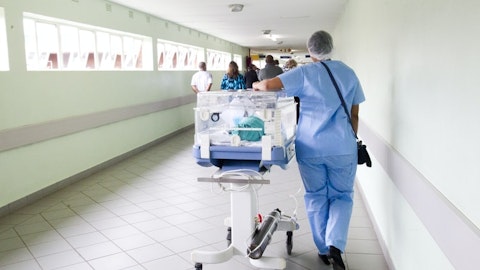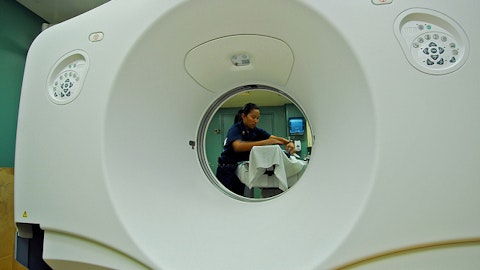Mitch Hill: And David, the thing I would add quickly is I think the growth in the emerging therapies is likely to be a little bit lumpy, I guess I would call it. And that’s both due to the fact that we have in some quarters a new product that’s been introduced. And you can kind of see that looking at the numbers for 2023, actually back to 2022 as well. And then also due to kind of the way these products are moved through the VAC approval process and timeline with the hospitals. And that takes x number of months typically for that to get through. And so the way those actually begin to impact the revenue line, it tends to be a little bit lumpy as opposed to really smooth.
David Rescott: Okay. So would it be fair to say that maybe all of these segments on a go forward basis and thus far are contributing to the growth and there doesn’t really appear to be a clear winner among the core products at or in your view, is there maybe a clear winner product so far?
Drew Hykes: So I do think all four will contribute on a go forward basis. On a relative basis, Artix is of course going to start from zero as we relaunch. So that will be pure incremental. Across the other three, I think they will grow as we move through the year. And to Mitch’s point, you might see some lumpiness driven by some of the new product introductions and the VAC approvals coming through across those respective new products.
Operator: Our next question comes from Richard Newitter from Truist Securities. Please go ahead.
Richard Newitter: Hi, thanks for taking the questions. And thanks for providing the revenue disclosure. Maybe just on kind of the pieces of the disclosure that you provided as they roll up to 2024. I’m just trying to get a sense directionally. Can you tell me if I’m directionally close? I’m getting to the midpoint of your guidance. Thinking about the core U.S.VTE in kind of the mid to high teens, I’m assuming international about 5% to 6% of revenue and that implies the leftover being the emerging therapies, I guess. Are those the directional components, understanding you strive to outperform the initial outlook? Are those a reasonable directional components of how to get to the midpoint of your guidance for now, specifically, we comment on that international as a percent of total in that 5% to 6% range?
Mitch Hill: Hi, Richard. Thanks for the question. I think we closed out the year with international at 6%. That’s something – it’s going to continue to make progress. I think there’s potentially some step up as we move through the year, as we continue to get more traction and the more developed markets as well. We may have some additional products for sale at some point in these markets. I mentioned earlier during the call that we’re still pursuing regulatory approval for many of the new product things that we’ve launched. As Drew mentioned, we think that the international contribution from China and Japan is likely to be very modest and probably more back end kind of loaded. In terms of thinking about 2024, from the point of view of the other pieces of the puzzle, in terms of your revenue build, I think you’re kind of headed in the right direction there in terms of how that’s – certainly how we closed out the year 2023 and then how we’ll kind of think about 2024.
Richard Newitter: Okay. And just to be clear, so maybe international, even though you have incremental emerging therapies contribution international to percentage of sales, still will gravitate higher than the 6% than 2023.
Mitch Hill: Yes, that’s what we expect.
Richard Newitter: Okay. Thank you very much.
Mitch Hill: I think Drew’s talked about that longer term growing into a 20% type factor, but certainly that’s going to be a multi-year build to that level.
Richard Newitter: Thank you.
Mitch Hill: Sure.
Operator: Our last question comes from Mike Matson from Needham & Company. Please go ahead.
Mike Matson: Yes, thanks. So just wanted to ask one on LimFlow. So you mentioned this NTAP opportunity, so I assume it’s been applied for, but you don’t know whether or not you’re getting it yet. Is that right? And how critical is that to driving adoption of the product in your view?
Drew Hykes: Yes, great question, Mike. I’m happy to get started on that. So far so good with LimFlow. We closed in November. We made some really nice progress on the integration front, and we’ve also made some nice progress on the initial U.S. launch. We obviously don’t have access to the NTAP today. But if you look at the existing reimbursement – inpatient reimbursement today at our target first group of limb salvage centers. It is in the neighborhood of $30,000. So it is a positive contribution margin procedure even today with the existing reimbursement. We have applied for NTAP and are confident we will receive it. It will go into effect in October, and that will add incrementally about another $16,000 in incremental reimbursement on top of the existing DRG.
So it obviously provides a lot of incremental economic value to the hospital at that point. But even today, in advance of the NTAP, we are gaining VAC approvals and beginning to do initial cases in the U.S. And I think the economic value proposition is broader and ties back into LimFlow being a really important part of any limb salvage center, armamentarium. And some of the broader economic considerations, I think, are helping fuel the growth here and the traction even in advance of the NTAP, which again, we anticipate coming online in October.
Mike Matson: Okay, thanks. And then I know there’s a lot of focus on competition from Penumbra, but I just want to ask if you’d seen any sort of impact from Boston Scientific’s REAL-PE study. I think that it was presented at TCT kind of in the fall. Did that drive any kind of pick up in their EKOS [ph] sales or I mean that you could see your share gain from you guys?
Drew Hykes: Yes, I think Tom might have some perspective to share on that data set and the impact.
Tom Tu: Yes, thanks for the question, Mike. So, first of all, to call the REAL-PE data set a trial, I think is maybe overstating its value. It really was kind of an exercise in electronic medical record assessment. And what it showed is that when you retrospectively look at who got FlowTriever, you oftentimes saw patients who were too sick to get any other therapies. You got patients who are actively bleeding, who got the only therapy that really was appropriate for somebody who cannot get lytics [ph] and that would be mechanical thrombectomy. So I think it was a nice exercise in selection bias. I think the vast majority of physicians see it for what it is. We’re excited about PEERLESS, because PEERLESS is actually high quality randomized data. And I think that the community can’t wait to see the results of that. We really have not seen any commercial impact from that data release.
Mike Matson: Okay, got it. Thank you.
Drew Hykes: Thank you, Mike.
Operator: This concludes our conference call. Thank you for attending today’s presentation. You may now disconnect.


